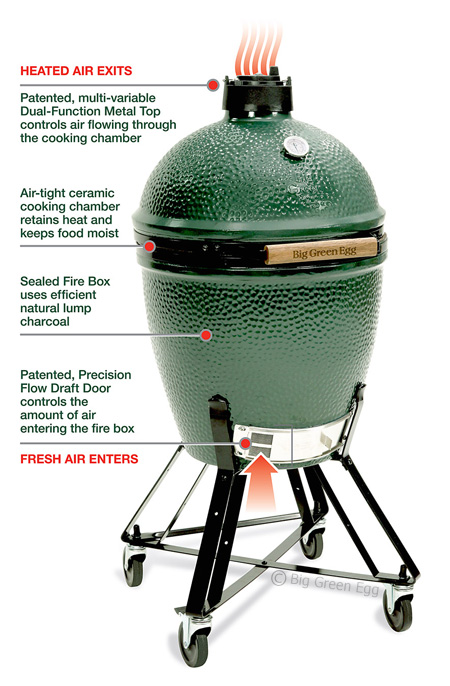Anyone who is slightly befuddled by the title of this post probably isn’t a member of the cult of ceramic grills, which are also known by their Japanese name of kamado grills. I used to be one of those people who sneered at my friends who went on and on about how wonderful their Big Green Eggs were and how they could cook perfect ribs or chickens or pork shoulders all the time because of the incredibly well-insulated ceramic grills’ ability to hold a constant temperature for so long.
“They’re just weak,” I thought. “Part of being a pitmaster is the ability to constantly adjust your heat source and air flow to try to compensate for flare-ups and hot or cold spots in your grill.” Heck, I even bragged about how well I could smoke meat on my gas grill, thanks to the use of a smoke box and wood chips. Then I broke down and bought a ceramic grill…
You can officially color me a member of the kamado zombie cult now as I sing their praises to anyone who will listen. In fact, after I bought my first ceramic grill, a Primo XL for our cabin up in the mountains, it wasn’t a month before I bought a Medium Green Egg for the back deck at my house. Why are they so amazing? Take a look at this illustration from the folks at Big Green Egg:
The design and construction of ceramic cookers allows for an incredibly efficient use of charcoal to maintain a constant temperature inside the cooking area. As opposed to thin-walled kettle grills or gas grills that for safety reasons have to have multiple open area for fumes (and heat) to escape, kamados are almost completely air-tight. With just minute adjustments of the air vents below and above the fire box, you can achieve and maintain temperatures as low as 150 degrees for smoking fish or as high as 800-900 degrees for searing a steak Pittsburgh-style.
Because the energy usage is so efficient, you burn much less charcoal than with a traditional grill. These grills use natural lump charcoal and can hold a temperature overnight while you smoke a pork shoulder. Gone are the days of setting your alarm for the middle of the night to wake up and restoke the fire. You should never use any starting fluid in these grills, especially because the porous ceramic walls of the cooker will soak that nasty stuff up and make all your food taste like a petroleum product. Yuck.
Now that I’m the proud owner of two of these grills, both of which are manufactured in Georgia, I’m in a unique position. No, not broke, but close. These things are pretty darned expensive, but I keep trying to rationalize the cost by my savings on charcoal and propane. My unique position is that I can directly compare the Big Green Egg and the Primo, two of the most popular ceramic grills on the market.
First off, let’s look at the Egg.



Great stuff, we have a Primo XL and Primo Junior and we would never buy a Green Egg as long as we have the option to buy Primo and buy American!
Here you go, Shaun:
http://www.geardiary.com/how-to-submit-your-product-for-review/
In the case of these products, Chris mentioned in the article that he had purchased each with his own money. =)
Judie Lipsett Stanford
Editor in Chief
http://www.geardiary.com
325.374.2554
information about production is incorrect…. Primo is the ONLY kamado made in the USA. The Green Egg is made in Mexico. Company is ‘based in Tucker, GA’ with production in Mexico! PRIMO all the way… for MANY reasons!
I’ve had a Primo XL for five year and love it! We use it at least once/twice all year long (Alabama) and have had no issues. The gasket can be a pain but if you purchase a good, high quality replacement only the bottom needs to be replaced. If you want to cook ribs, do not buy an Egg.
I’ve been told by local dealers who don’t sell Primo’s that: 1) Their customer service is bad 2) The bracket holding the lid would loosen on its own making it possible for the lid to fall off.
Fortunately, the product is solid and I’ve never needed support. Regardless, I seriously doubt a customer (as opposed to a reseller) would have an issue. Also, my lid bracket is as tight today as it was over five years ago. Don’t believe the sales guy pushing the Egg or Kamado Joe.
I had a large Green egg and sold it and purchased a XL Primo.. I agree totally with your logic how easy it is to stage meat especially Ribs…. 7 racks fit nicely.. I took one step further and made my stand out of Epay… Brazilian Walnut.. advantage is will not soak in oils or grease… disadvantage besides being expensive, it will break carbide bites, stainless steel screws and saw blades like nothing…. but nice. good job on the article.
Got any pictures of your stand???
I have the Big Green Egg XL and it has more grill space than the Primo Oval XL. I can do direct and indirect at the same time and I have smoked meats for over 30 hours at 225 and lower with no need to add lump or wood. If you are considering a ceramic cooker, compare apples to apples. The BGE XL is the correct comparison to the Primo Oval XL.
By the way, both grills are fantastic and you will not be disappointed with either. Check out both company’s forums – great info out there.
Useful information. It is all I need. Thanks for your sharing